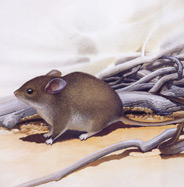A Gap in Nature
Air Date: Week of July 25, 2003
Tim Flannery has the next in our continuing series on the rise and fall of extinct species with a look at the rice rat of the West Indies.
Transcript
ROSS: Not everything gets a second chance in life. As part of our continuing series “A Gap in Nature,” author Tim Flannery chronicles the rise and fall of creatures who are no longer with us.
[AMBIENT MUSIC]
FLANNERY: The islands of the West Indies were once home to five unique species of giant rice rats, the oversized omnivorous rodents flourishing in the steamy island swamps. The Martinique giant rice rat, a splendid black and white creature the size of a housecat, was the largest and most abundant of these species.
 Until a century ago, these animals were a common sight on Martinique’s sprawling coconut plantations. The rats were strong swimmers – a talent which might have helped them survive the wrath of plantation workers, who did their best to exterminate them. They hated the rice rat for its relentless destruction of their crops.
Until a century ago, these animals were a common sight on Martinique’s sprawling coconut plantations. The rats were strong swimmers – a talent which might have helped them survive the wrath of plantation workers, who did their best to exterminate them. They hated the rice rat for its relentless destruction of their crops.
Rice rats also happen to be a popular dinner dish and became a regular feature on restaurant menus in Martinique. But cooking a giant rice rat was a rather laborious process. In order to reduce its musky odor, the hair had to be singed off and the body left in the open air overnight. It then had to be boiled in two different batches of water, before it would be declared edible. The final demise of the Martinique giant rice rat came rather abruptly, and unlike most species in the 20th century, man had nothing to do with it. On the 8th of May, 1902 at precisely 7:52 A.M., the Mt. Pelee volcano erupted, with a ferocity that devastated the entire island. The town of St. Pierre, a bustling metropolis of 30,000, was engulfed in ash and superheated volcanic gas. Only a single human survived, a condemned prisoner who was being held in a dungeon deep underground. He was eventually pardoned – perhaps for his miraculous survival – and joined Barnum and Bailey Circus to tour the world as “the lone survivor of St. Pierre.” The rice rats were not so lucky. They evidently perished, either in this volcanic eruption or the ones that followed later that year. For the Martinique giant rice rat was never heard from again. ROSS: Tim Flannery is author of “A Gap In Nature: Discovering the World's Extinct Animals.” To see a picture of the rice rat, and hear other segments in our series, go to our website: living onearth.org. That's livingonearth.org. Living on Earth wants to hear from you!Living on Earth Newsletter [Click here]
Donate to Living on Earth! NewsletterLiving on Earth offers a weekly delivery of the show's rundown to your mailbox. Sign up for our newsletter today!
|





